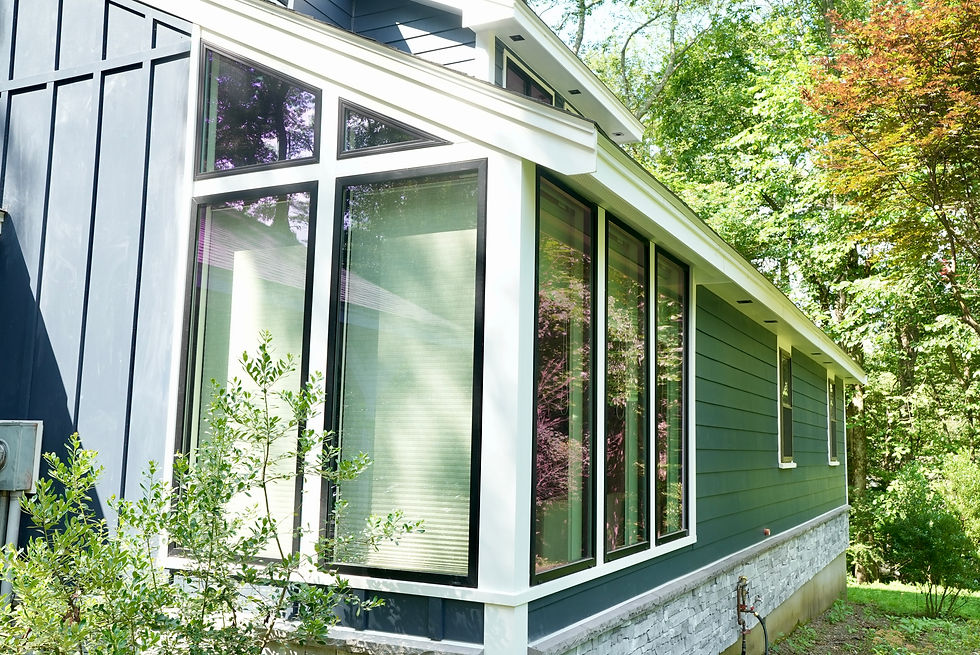What to Replace First: Roof, Windows, Siding or Doors?
- Refined Home Services

- Nov 13
- 3 min read
Homeowner’s Dilemma: Roofing, Windows, or Siding?
When your home’s exterior starts showing its age—peeling siding, drafty windows, worn shingles, sticky doors—it’s tempting to tackle everything at once. But here’s the truth: the order you do these projects matters more than you might think.
Choosing the right sequence can:
Save thousands in rework costs
Prevent damage to new installations
Improve your home’s energy efficiency faster
Help you plan around weather and contractor timelines
So… should you replace the roof, windows, siding, or doors first? Let’s break it down.

Step 1: Start With the Roof
Your roof is your home’s first line of defense. If it leaks or traps moisture, every other upgrade below it is at risk.
Do the roof first if:
You notice leaks, missing shingles, or sagging spots
Your roof is 15–20+ years old
You’re planning new siding or attic insulation
Replacing the roof first protects new siding and windows from water damage during installation. It also allows contractors to update flashing and trim that might affect how siding or gutters are installed later.

Step 2: Replace Windows and Doors
Next, tighten up your home’s “envelope.” Windows and doors have a major impact on energy efficiency, comfort, and aesthetics.
Why second?Because it’s easier to tie in new window and door trims once your roofline details are complete—but before the siding is redone.
Do this step if you notice:
Drafts or cold spots near windows/doors
Condensation or fog between glass panes
Higher energy bills
Bonus tip: Energy-efficient windows and doors can help you qualify for rebates and boost your home’s resale value.

Step 3: Refresh or Replace Siding
Once the roof and openings are sealed, turn to your siding—the “skin” of your home.
Why third? Siding is often integrated around windows and doors. If you replace the siding first and install new windows later, you’ll likely have to remove and reinstall the siding around them. That means paying twice.
Look for these signs it’s time for new siding:
Cracking, warping, or fading
Mold or mildew growth
Soft spots or signs of rot
High maintenance or painting every few years
Pro tip: Choose insulated vinyl, fiber-cement, or engineered wood siding for low maintenance and energy savings.
Step 4: Upgrade Entry and Storm Doors (If Not Already)
Finally, enhance curb appeal with new doors. If your existing doors are structurally sound, they can come last—especially if you’re waiting for your new siding color to guide your design.
Why do doors last? Door trim often depends on final siding details, and swapping them too early can lead to gaps or misalignment later.
Home Condition | Best Order of Projects | Reasoning |
Roof issues or leaks | Roof → Windows/Doors → Siding | Protects the structure and prevents moisture damage |
Drafty but solid roof | Windows/Doors → Siding → Roof | Boosts comfort and efficiency first |
Cosmetic updates | Siding → Doors → Windows | Focuses on curb appeal |
Preparing to sell | Roof → Siding → Doors/Windows | Maximizes resale ROI and visual impact |
How to Plan Your Renovation the Smart Way
Assess current conditions – Have a professional inspection done for your roof, siding, and windows.
Budget by priority – Fix what protects your home first, beautify second.
Bundle when possible – Ask your contractor about package pricing for multi-system exterior upgrades.
Schedule for your region – In the Northeast, aim for spring to early fall to avoid weather delays.
Choose materials made for your climate – Roofing and siding that resist ice, snow, and wind will save long-term maintenance costs.
The Payoff: A Better, Stronger, More Efficient Home
When you follow the right sequence—roof → windows/doors → siding → finishing details—you end up with a home that looks beautiful, performs better, and costs less to maintain.
At Refined Home Services, we help homeowners plan projects strategically so every upgrade works together. Whether you’re starting with a roof replacement or a full exterior transformation, our team ensures every step supports the next.


